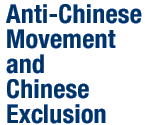

Top: Cover
Chinese immigration...,
Middle: Pages 28-29,
Chinese Photographed
by D.D. Beatty...,
Bottom: Cover & Pages 12-13,
Angel Island...
From their arrival during the Gold Rush, the Chinese experienced discrimination and often overt racism, and finally exclusion. Action often in the form of Legislation was used against Chinese immigrants and started as early as the 1850 foreign Miners' License Tax law. In 1854 was the California State Supreme Court categorizing Chinese with Blacks and Indians, and denying them there right to testify against white men in courts of law. During the 1870s, an economic downturn resulted in serious unemployment problems, and led to more heightened outcries against Asian immigrants. The Chinese often became the scapegoats for business owners who paid them low wages. This willingness to work for lower wages along with the productivity of the Chinese workers ignited the ire of white labor in California. Racist labor union leaders directed their actions and the anger of unemployed works at the Chinese, blaming them for depressed wages, lack of jobs, and accusing them of being morally corrupt. Denis Kearney, head of the Workingmen's Party of California, led this inflammatory battle against the Chinese. As a consequence of this hostility, local and statewide restrictions continued to be enforced against the Chinese. Eventually, the United States government passed the Chinese Exclusion Act of 1882. This barred Chinese laborers from immigrating for ten years. Only officials, teachers, students, merchants, and travelers were allowed to enter. The Chinese currently in the United States were barred from naturalization. China, as the home country for these immigrants, was unable to exert any influence on American policy. This law stood in place till it was repealed in 1943.
In 1905, construction of an Immigration Station on Angel Island began in the area known as China Cove. Surrounded by public controversy from its inception, the station was finally put into operation in 1910. Anticipated as the "Ellis Island of the West", it was designed to handle a flood of European immigrants who were expected to begin arriving in California once the Panama Canal was opened. Instead, the majority of immigrants to America via the West Coast were from Asia. Like their European counterparts entering at New York City, they hoped to escape the economic or political hardships of their homelands. On Ellis Island, immigrants were processed through within hours or days; on Angel Island, they spent weeks or months. This facility was primarily a detention center. Beginning with the Chinese Exclusion Act of 1882, a series of restrictive laws had prohibited the immigration of certain nationalities and social classes of Asians. Although all Asians were affected, the greatest impact was on the Chinese. In fact, more than 70 percent of the immigrants detained on Angel Island were Chinese.